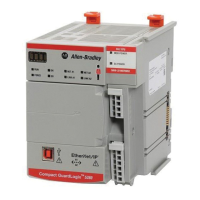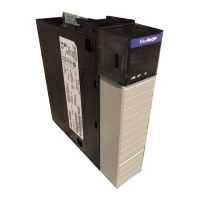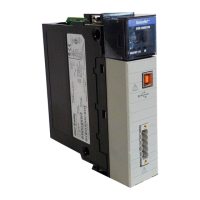218 Rockwell Automation Publication MOTION-RM003I-EN-P - February 2018
Notch Filter Tuning Threshold and that the frequency of the resonance be
between the configured Torque Notch Filter Low Frequency Limit and Torque
Notch Filter High Frequency Limit.
The Adaptive Tuning function sets the Torque Notch Filter Frequency Estimate
to the identified resonant frequency with the largest magnitude that meets the
configured Notch Tuning criteria.
A state machine, as defined in the functional requirements specification,
determines the Adaptive Tune Gain Scaling Factor and the Torque Low Pass
Filter Bandwidth Estimate. The current state also determines which drive
parameters are updated. The transition logic for the state machine is dependent on
the Adaptive Tuning status bits of the CIP Axis Status RA attribute and the
Adaptive Tuning Configuration.
When the drive axis is in any other state besides the Running state, the Adaptive
Tuning function is turned off and does not collect data.
When the drive transitions out of the Running state, the present values of all the
Adaptive Tuning status bits and output estimates will persist. When the drive
transitions into the Running state, the values of all the Adaptive Tuning status bits
are set to 0 and output estimates will persist until they are updated by the
Adaptive Tuning feature.
When the Adaptive Tuning Configuration is set to Disabled or Tracking Notch,
the Adaptive Tune Gain Scaling Factor is reset to one. In this case the configured
Torque Notch Filter Frequency, Torque Low Pass Filter Bandwidth, Load
Observer Bandwidth, Load Observer Integrator Bandwidth, Velocity Loop
Bandwidth, Velocity Loop Integrator Bandwidth, Position Loop Bandwidth, and
Position Loop Integrator Bandwidth attribute values are not impacted by the
Adaptive Tuning function.
Torque Notch Filter High Frequency Limit
Usage Access T Data
Type
Default Min Max Semantics of Values
Optional - C Set/SSV
REAL FD 20 2*FD Filter Frequency Units
This value sets the upper limit on the Torque Notch Filter Frequency Estimate
value for the Adaptive Tuning function. The frequency of an identified natural
resonance must be lower than this limit to be applied to the Torque Notch Filter
Frequency Estimate.

